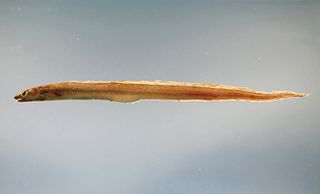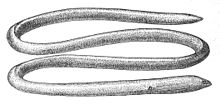
Fortuna is a city on the northeast shore of the Eel River, and is on U.S. Route 101 in west-central Humboldt County, California, United States. The population was 11,926 at the 2010 census, up from 10,497 at the 2000 census.

The electric eel is a South American electric fish. Until 2019, it was classified as the only species in its genus. Despite the name, it is not an eel, but rather a knifefish. It is considered as a fresh water teleost which contains an electrogenic tissue that produces electric discharges.

The swamp eels are a family (Synbranchidae) of freshwater eel-like fishes of the tropics and subtropics. Most species are able to breathe air and typically live in marshes, ponds and damp places, sometimes burying themselves in the mud if the water source dries up. They have various adaptations to suit this lifestyle; they are long and slender, they lack pectoral and pelvic fins, and their dorsal and anal fins are vestigial, making them limbless vertebrates. They lack scales and a swimbladder, and their gills open on the throat in a slit or pore. Oxygen can be absorbed through the lining of the mouth and pharynx, which is rich in blood vessels and acts as a "lung".

Moray eels, or Muraenidae, are a family of eels whose members are found worldwide. There are approximately 200 species in 15 genera which are almost exclusively marine, but several species are regularly seen in brackish water, and a few are found in fresh water.

Eels is an American rock band, formed in Los Angeles, California in 1991 by singer/songwriter and multi-instrumentalist Mark Oliver Everett, known by the stage name E. Band members have changed across the years, both in the studio and on stage, making Everett the only official member for most of the band's work. Eels' music is often filled with themes about family, death, and unrequited love. Since 1996, Eels has released thirteen studio albums, seven of which charted in the Billboard 200.

Conger is a genus of marine congrid eels. It includes some of the largest types of eels, ranging up to 2 m (6 ft) or more in length, in the case of the European conger. Large congers have often been observed by divers during the day in parts of the Mediterranean Sea, and both European and American congers are sometimes caught by fishermen along the European and North American Atlantic coasts.

The Congridae are the family of conger and garden eels. Congers are valuable and often large food fishes, while garden eels live in colonies, all protruding from the sea floor after the manner of plants in a garden. The family includes over 180 species in 32 genera.

Ophichthidae is a family of fish in the order Anguilliformes, commonly known as the snake eels. The term "Ophichthidae" comes from Greek ophis ("serpent") and ichthys ("fish"). Snake eels are also burrowing eels, they are named for their physical appearance, they have long, cylindrical snakelike bodies. This family is found worldwide in tropical to warm temperate waters. They inhabit a wide range of habitats, from coastal shallows and even rivers, to depths of above 800 m (2,600 ft). Most species are bottom dwellers, hiding in mud or sand to capture their prey of crustaceans and small fish, but some are pelagic.
The Anguillidae are a family of ray-finned fish that contains the freshwater eels. Eighteen of the 19 extant species and six subspecies in this family are in the genus Anguilla. They are elongated fish with snake-like bodies, their long dorsal, caudal and anal fins forming a continuous fringe. They are catadromous fish, spending their adult lives in fresh water, but migrating to the ocean to spawn. Eels are an important food fish and some species are now farm-raised, but not bred in captivity. Many populations in the wild are now threatened, and Seafood Watch recommend consumers avoid eating anguillid eels.

The superorder Elopomorpha contains a variety of types of fishes that range from typical silvery-colored species, such as the tarpons and ladyfishes of the Elopiformes and the bonefishes of the Albuliformes, to the long and slender, smooth-bodied eels of the Anguilliformes. The one characteristic uniting this group of fishes is they all have leptocephalus larvae, which are unique to the Elopomorpha. No other fishes have this type of larvae.

The cusk-eel family, Ophidiidae, is a group of marine boney fishes in the order Ophidiiformes. The scientific name is from the Greek ophis meaning "snake", and refers to their eel-like appearance. True eels, however, diverged from other ray-finned fish during the Jurassic, while cusk-eels are part of the Percomorpha clade, along with tuna, perch, seahorses, and others. Unlike true eels of the order Anguilliformes, cusk-eels have ventral fins that are developed into a forked barbel-like organ below the mouth. In the true eels by contrast, the ventral fins are never well-developed and usually missing entirely.

Snipe eels are a family, Nemichthyidae, of eels that consists of nine species in three genera. They are pelagic fishes, found in every ocean, mostly at depths of 300–600 m but sometimes as deep as 4000 m. Depending on the species, adults may reach 1–2 m (39–79 in) in length, yet they weigh only 80-400 g. They are distinguished by their very slender jaws that separate toward the tips as the upper jaw curves upward. The jaws appear similar to the beak of the bird called the snipe. Snipe eels are oviparous, and the juveniles, called Leptocephali, do not resemble the adults but have oval, leaf-shaped and transparent bodies. Different species of snipe eel have different shapes, sizes and colors. The similarly named bobtail snipe eel is actually in a different family and represented by two species, the black Cyema atrum and the bright red Neocyema erythrosoma.

Nettastomatidae, the duckbill eels or witch eels are a family of eels. The name is from Greek netta meaning "duck" and stoma meaning "mouth".
The Eel is an alias used by two fictional characters appearing in American comic books published by Marvel Comics. The first character to take up the identity was Leopold Stryke who first appeared in Strange Tales #112 created by Stan Lee and Dick Ayers, while his successor, Edward Lavell, first appeared in Power Man and Iron Fist #92. Both Eels were at one point members of the Serpent Squad even though the character they portray was not actually based on a snake, but on a fish that resembled a snake. Neither Eel has ever been featured as a regular character in any of Marvel's ongoing or limited series.

An eel is a ray-finned fish belonging to the order Anguilliformes, which consists of eight suborders, 19 families, 111 genera, and about 800 species. Eels undergo considerable development from the early larval stage to the eventual adult stage, and most are predators.

Eels are elongated fish, ranging in length from 5 centimetres (2.0 in) to 4 metres (13 ft). Adults range in weight from 30 grams to over 25 kilograms. They possess no pelvic fins, and many species also lack pectoral fins. The dorsal and anal fins are fused with the caudal or tail fin, forming a single ribbon running along much of the length of the animal. Most eels live in the shallow waters of the ocean and burrow into sand, mud, or amongst rocks. A majority of eel species are nocturnal and thus are rarely seen. Sometimes, they are seen living together in holes, or "eel pits". Some species of eels live in deeper water on the continental shelves and over the slopes deep as 4,000 metres (13,000 ft). Only members of the family Anguillidae regularly inhabit fresh water, but they too return to the sea to breed.

The goldspotted eel, also known as the goldspotted snake eel or the dark-spotted snake eel, is an eel in the family Ophichthidae. It was described by Charles Alexandre Lesueur in 1825, originally under the genus Muraenophis. It is a marine, tropical eel which is known from the western and eastern Atlantic Ocean, including Bermuda, southern Florida, USA; the Bahamas, Santa Catarina, and Brazil. It dwells at a maximum depth of 15 metres (49 ft), and inhabits rocky and coral reefs. Males can reach a maximum total length of 110 centimetres (3.6 ft).

The many-eyed snake-eel is a species of eel in the family Ophichthidae. It was described by Pieter Bleeker in 1864. It is a tropical, marine and freshwater-dwelling eel which is known from the Indo-Pacific, including East Africa and the Hawaiian Islands. It dwells at a depth of 2 to 25 metres, and inhabits sand and rubble sediments near coral reefs. Males can reach a total length of 62.5 centimetres (24.6 in).

The Bean's sawtooth eel is an eel in the family Nemichthyidae. It was described by Theodore Gill and John Adam Ryder in 1883. It is a marine, deep water-dwelling eel which is known from throughout the Atlantic Ocean, the Indian Ocean, and the Western Pacific Ocean, including Iceland, South Africa, Réunion, and Australia. It dwells at a depth range of 0–5998 metres, and leads a solitary lifestyle. It migrates vertically at night. Males can reach a maximum total length of 78-80 centimetres, making it the largest sawtooth eel.

Manu Maʻu is a rugby league footballer who plays as a second-row forward for Hull F.C. in the Betfred Super League. He has played for both Tonga and New Zealand at international level.



















